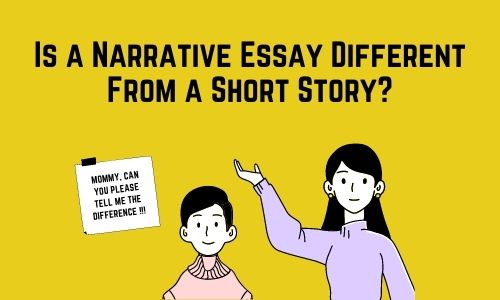Difference between short story and narrative essay
In day-to-day lives, students have to deal with different kinds of writing tasks. Some of them are completely different from each other. It’s easy to tell the difference between a research paper and a descriptive essay. However, the difference between short story and narrative essay may not be easy to differentiate. They may seem to have a lot of things in common because in both cases, you tell a story. Well, the truth is that these two types of assignments are not as similar as they seem.
Usually, the term “narrative” is used when we talk about different kinds of writing styles, including essays, novels, and short stories. Different kinds of writing, however, are associated with different narratives. A narrative essay tells a true story or a real-life experience. In contrast, a short story requires you to come up with a fictional plot and characters.
Understanding the distinctive features of different kinds of narratives enables you to improve your writing skills and to choose the right approach for each type of assignment.
If you’re struggling to understand the difference between these writing assignments, you can use some help from a company that specializes in writing academic papers like that. LegitWritingServices may help you choose a popular essay writing service among dozens of different options and find a writer for your narrative essay in minutes. But if you want to know the difference, write it yourself or improve your understanding of different writing styles, just read on.
Short Story vs. Narrative Essay
First of all, these two types of writing styles do have something in common: they basically consist of the same elements. Both narrative essays and short stories should have a plot and characters, as well as a climax and resolution. In both cases, you may use dialogues.
Now let’s take a closer look at the differences:
1. Fiction and facts
Perhaps, the main difference between narrative essays and short stories is that the former simply writing about things that have actually happened, while the latter is based on fiction. When writing narrative essays, you can rely on your personal experiences and facts from real life. Short stories require you to use your imagination, making up characters and events. Therefore, the key to writing short stories is creativity, while a good narrative essay must be factual so you shouldn’t change events.
2. Thesis statement
Another important difference is determined by the very nature of the essay format. Many essays are based on a thesis statement and narrative essays are no exception. Usually, the thesis statement is presented in the very first paragraph, within the introduction. According to the UNC, the thesis statement represents the main idea of the entire essay. When writing narrative essays, your thesis statement may focus on what you’ve learned from a certain experience or how it influenced your life. The rest of your essay should illustrate your thesis statement and prove its validity.
Unlike essays, short stories don’t have a thesis statement. Moreover, short stories may not even have a main theme that ties together different events. In a short story, you may illustrate the impact of love, fear, loss, or other things. You can, however, let readers figure out the main theme rather than state it explicitly.
3. Point of view
Usually, narrative essays provide the first-person perspective. This way, you can highlight the significance of your personal experience and you become one of the characters or, in most cases, the main character. In contrast, short stories enable you to choose any perspective you like. You can still use the first person, but you can also choose the third person voice and therefore distance yourself from the events and characters described in the story.
4. Structure
You may have already noticed that short stories give you a lot more creative freedom. The same applies to the structure as well. When writing a short story, you can leap right to the middle of the action from the very beginning. You can decide on the starting and ending points of your story and place your readers wherever you want.
This isn’t the case with narrative essays because all essays should have a clear structure. Your narrative essay should start with an introduction, where you can explain the background of the events described in the essay and present your thesis statement. After this, you should write the main body, describing events in a logical or chronological order. The main body itself should be well-structured, with every paragraph being dedicated to a particular event or point. The conclusion section should briefly summarize the whole essay and it can also explain how your story proves the thesis statement.
5. Intention
Your narrative essay may aim to communicate some deep meaning and teach your audience an important lesson. At the same time, a narrative essay is based on real events and therefore it can also be informative. Given that you describe real events, your readers can get first-hand knowledge and better understand relevant topics.
A short story is aimed to entertain. A good short story can also teach your audience a lesson, but you won’t achieve this goal if you don’t make your story entertaining and engaging.
Conclusion:
Now that you know the difference between narrative essays and short stories, it will be easier for you to choose the right approach when dealing with each of these assignments. Make sure that you clearly understand the format requirements before you start to write and don’t forget that even non-fiction writing can always benefit from some form of creativity.

